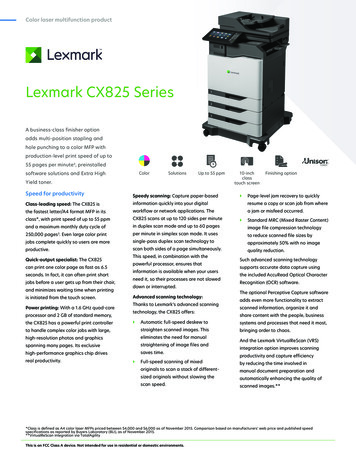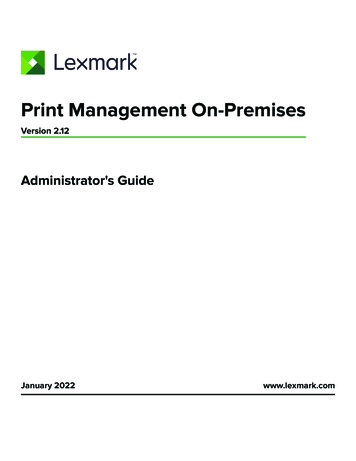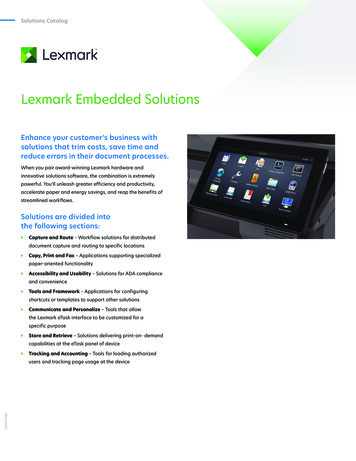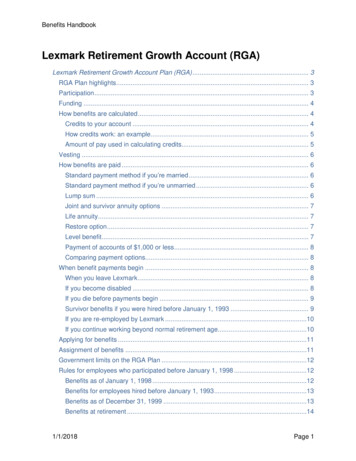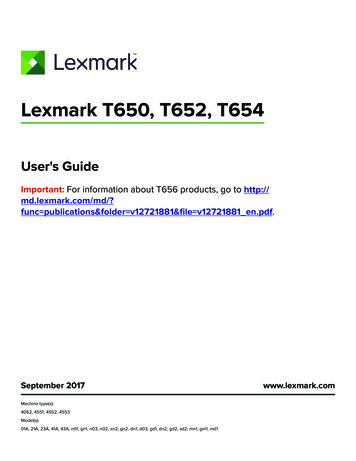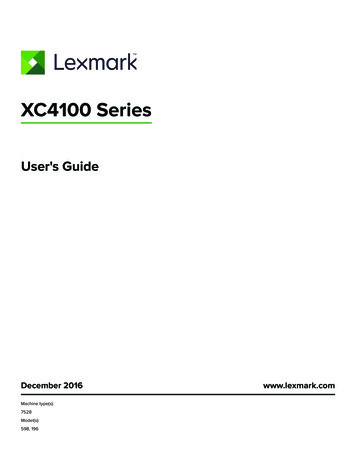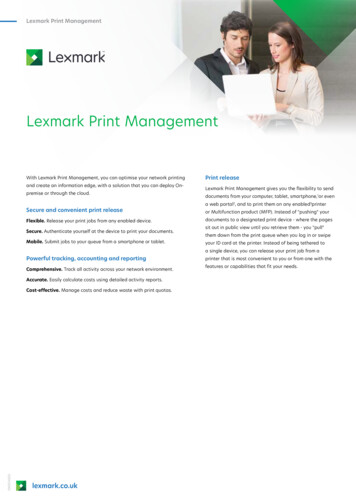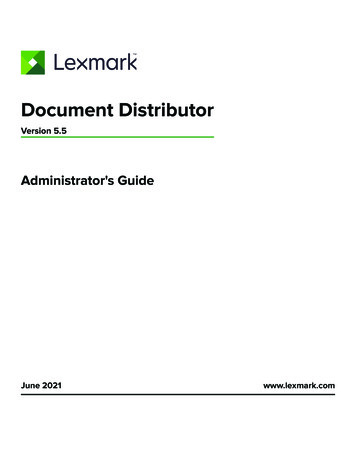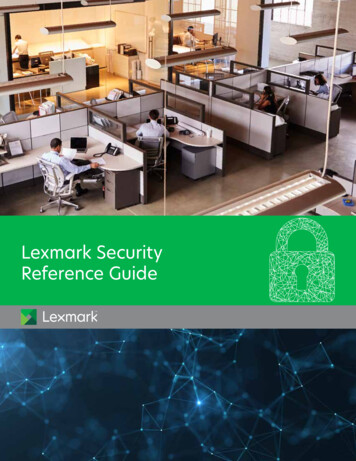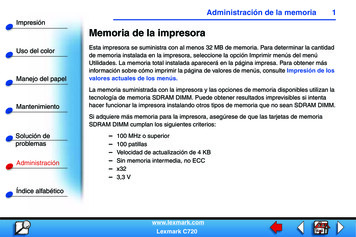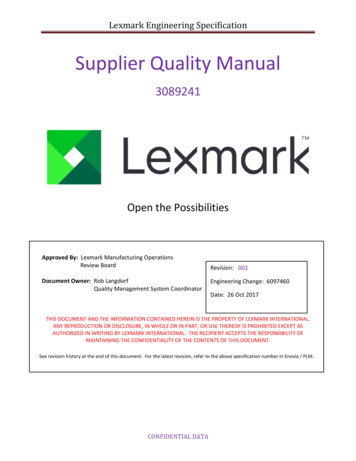
Transcription
Lexmark Engineering SpecificationSupplier Quality Manual3089241Open the PossibilitiesApproved By: Lexmark Manufacturing OperationsReview BoardDocument Owner: Rob LangdorfQuality Management System CoordinatorRevision: 002Engineering Change: 6097460Date: 26 Oct 2017THIS DOCUMENT AND THE INFORMATION CONTAINED HEREIN IS THE PROPERTY OF LEXMARK INTERNATIONAL.ANY REPRODUCTION OR DISCLOSURE, IN WHOLE OR IN PART, OR USE THEREOF IS PROHIBITED EXCEPT ASAUTHORIZED IN WRITING BY LEXMARK INTERNATIONAL. THE RECIPIENT ACCEPTS THE RESPONSIBILITY OFMAINTAINING THE CONFIDENTIALITY OF THE CONTENTS OF THIS DOCUMENT.See revision history at the end of this document. For the latest revision, refer to the above specification number in Enovia / PLM.CONFIDENTIAL DATA
3089241Supplier Quality ManualRev. 0021. PurposeLexmark and its suppliers should aim to produce products with zero defects during the manufacturingprocess and no failures while in use by customers. This manual is intended to define and communicatethe quality system requirements, policies, practices, responsibilities, and other information necessaryfor a Supplier to design, manufacture, and/or assemble Lexmark products toward that objective.2. ScopeThis manual and its related reference documents are applicable to all manufacturing sites producingLexmark products, subsystems and modules. This includes service parts such as Field Replaceable Units(FRUs) and Customer Replaceable Units (CRUs) where applicable.3. Reference and other Applicable Documents3.13.2 Reference documents related to this manual:3089241T1 – Supplier Project Quality Plan Template (SPQP)3089241R1 – Procedure for Managing SPQP in Enovia3089241R2 – Quality Roles and Responsibilities Matrix3089241C1 – Supplier Quality Manual Audit ChecklistRelated Standards:3087433 – Audit Program Management Procedure3085125 – Supplier and Interplant Packaging and Handling Specification – Part 13088434 – Supplier Performance Management Process (SPMP) Quality ElementCONFIDENTIAL DATAPage 2
Lexmark Engineering Specification4. Definitions and Acronyms Critical Process – a manufacturing process that requires some kind of control to make sure it isalways done correctlyDevelopment Build – a product build during the development of the product whose output isprimarily used to reduce the knowledge gaps associated with the design and the manufacturingprocess. These builds may contain some prototype parts.FST – Final System Test – the last development build where the Product is used in the finalvalidation test of the completed product design. This is a system level test of the Product that isintended to be ready to ship to customers where the expectation is there are no changes madeto the hardware, software, or firmware.Lexmark-approved – where used in this document, the subject deliverable must be explicitlyapproved by one of the following: The responsible Global Sourcing Manager or the responsibleOperations/NPI Engineering Team Manager.Module – a subassembly for a finished product that includes multiple components and istypically managed separately from the printer. The following are most commonly classified asModules:o Laser Scanning Unit (LSU)o Fuser Assemblyo Scanner Assemblyo Printed Circuit Board Assembly (PCBA)o Power Supply Unit (PSU)o Operation Panel (OP)o Supplies (1-Piece Cartridge Assembly or Toner Cartridge and Imaging Unit)MRR – Manufacturing Readiness Review – A Lexmark process for assessing manufacturingreadiness using a comprehensive checklist that includes several quality-related deliverables.NPI – New Product EngineeringOEM – Original Equipment ManufacturerPHD – Paper Handling Devices – Used to describe optional input and output devices that acustomer can buy to add tray capacity and/or paper handling functionality to the printer.PLM – Product Lifecycle Management – term is used in conjunction with a software system thatis used as the complete design record and history. The current Lexmark-managed PLM systemis Enovia.PTB – Production Tooled Build – a development build performed prior to Start of Productionwhere the components used have been manufactured from the tools intended for finalproduction. These builds typically take place during the Design Iteration Phase. This is differentfrom “prototype” builds where components used are not from production tooling.QE – Lexmark Quality Engineer – The Lexmark engineer who has overall quality planningresponsibility. This may be someone with a different job title, such as NPI Engineer or ProgramManager, but should be specifically designated by Lexmark Management to fill the QE rolethroughout the product lifecycle (responsibility may be transferred as needed).RFQ – Request for Quote – The formal request made by Global Sourcing to a potential supplierto quote a project.RMA – Return Material AuthorizationSOP – Start of ProductionSQM – Supplier Quality Manual (this document)CONFIDENTIAL DATA
3089241Supplier Quality ManualRev. 0025. Work FlowFollowing is a graphical depiction of the project quality planning process: Product lifecycle phases across the top Lexmark and Supplier departments along the left sideCONFIDENTIAL DATAPage 4
3089241Supplier Quality ManualRev. 0026. Roles and Responsibilities6.1General Roles and Responsibilities – General responsibilities for Lexmark and Suppliers aredescribed in detail in 3089241R2 – Quality Roles and Responsibilities Matrix.6.2Quality Planning Roles and Responsibilities – Responsibilities for Lexmark and Suppliers aredescribed in the process described in Sections 9.2 through 9.7 of this document. The workflow depictedin Section 5 also provides a visual depiction of the various tasks associated with each role.6.3Lexmark Quality Engineer – As defined in Section 3, a Lexmark engineer shall be designated asthe Quality Engineer throughout the life of a project. Throughout this document and its references, theterms “Quality Engineer” and “QE” refer to this person, regardless of their job title.7. Equipment and MaterialsThere are no specific equipment or materials required for this standard. Other standards that this onerefers to may have specific equipment and/or materials requirements listed.8. Applicable Systems, Programs and/or Files8.1See the various standards for specific systems requirements related to those standards.8.2SPQP Management - Enovia is required for managing quality plan documentation.8.2.1 The SPQP document for each program should be created using the latest version of3089241T1 – Supplier Project Quality Plan Template (SPQP).8.2.2 3089241R1 – Procedure for Managing SPQP in Enovia provides detailed instructionsregarding creating, modifying, approving and uploading the SPQP into Enovia.9. Process9.1General Supplier Requirements9.1.1 All suppliers of Lexmark products are expected to have a sustainable, comprehensiveand documented quality management system based on ISO 9001 (or Lexmark-approvedequivalent). The Supplier is responsible to maintain ISO 9001 (or Lexmark-approved equivalent)certification at all times.9.1.2 Each supplier shall be responsible for their outgoing product quality includingmaintaining and supporting all necessary processes required for developing, designing,manufacturing, assembling and shipping of quality products whether or not the processes arespecifically identified in this document.9.1.3 The Supplier is responsible for a product configuration management system thatensures products are manufactured to match the PLM-defined Lexmark Bill of Materials (BOM)for all variants of the products that the Supplier manufactures. Lexmark systems such as Orionmay be part of this product configuration management system, however the Supplier isultimately responsible for the quality and accuracy of all manufactured products.CONFIDENTIAL DATAPage 5
3089241Supplier Quality ManualRev. 0029.1.4 Subsupplier control, incoming quality control, process controls, and any other qualityprocesses required to assure stable manufacturing/assembly/system quality levels as well ascompliance with all relevant regulatory requirements are the responsibility of the Supplier.9.2Pre-Quote Activity9.2.1Pre-Quote Supplier Project Quality Plan (SPQP)In preparation for an upcoming RFQ activity, the Lexmark Quality Engineer is responsible toprepare a summary of all known project specific quality requirements to be shared withpotential suppliers. In some cases, the requirements related to current similar product may beused as proxy and updated later as appropriate. These requirements are to be summarizedusing Template 3089241T1 – Supplier Project Quality Plan Template. This may include any or allof the following: Special/critical process requirements, including requirements for facilities such as cleanrooms, ventilation hoods, specialty room lighting, etc. In-process inspection and testing requirements, including test plans Product Inspection (PI) testing requirements, including test plans Quality Reporting Requirements Quality Targets, including initial product and process targets as defined in 3088434 –Supplier Performance Management Process (SPMP) Quality Element. Unique OEM quality requirements. A list of all Lexmark and industry standards that are applicable to the project, referringto the standards identified in this document (SQM). A list of the quality deliverables due to be reviewed at each review phase.The completed SPQP should be given to the responsible Global Sourcing Relationship Managerto include with the RFQ. If needed, the Global Sourcing Relationship Manager may also providecopies of the Lexmark and industry standards that are identified in the SPQP.9.3Program Quoting9.3.1Providing Quality Requirements to Prospective SuppliersThe responsible Global Sourcing Relationship Manager includes the following documentation asexhibits in the RFQ package: The pre-quote Supplier Project Quality Plan (SPQP) as described in section 9.2.1 The Supplier Quality Manual (this document) The latest version of applicable requirements documents called out in the SPQP (ifneeded—the Supplier may already have access to some or all of them)The Global Sourcing Relationship Manager should expect the Supplier to acknowledge thisinformation as part of their quoted response. If the Supplier expresses any concerns related tothe SQM and/or SPQP, the Global Sourcing Relationship Manager should share these with theQuality Engineer. This should allow all parties the opportunity to seek further clarification ornegotiation if needed before awarding the project.CONFIDENTIAL DATAPage 6
30892419.4Supplier Quality ManualRev. 002Post-Award Activity9.4.1Initial Supplier Project Quality Plan (SPQP)As soon as possible following the award of the project by Global Sourcing (typically within 60days), the Quality Engineer schedules an Initial Project Quality Review as described in section12.1. The focus of this review is to ensure that both Lexmark and Supplier teams understandthe basic quality requirements and deliverables associated with the SPQP.When all parties have agreed, the SPQP shall be signed/approved and become the plan ofrecord throughout the development and early production phases of the project.Changes to the SPQP shall be controlled as described in section 9.7.9.5Development Build Support and Quality Planning9.5.1Development Build Support ActivitiesThe Supplier shall provide development build support as directed in the contract and purchaseorders. All product manufactured during the development builds is expected to meet the statedspecifications and drawing requirements. The Supplier shall be responsible for the cost tocorrect any product that does not meet requirements due to the Supplier’s failure to meetstated requirements.9.5.2Quality Deliverables and CheckpointsDuring the development of the manufacturing process, the Supplier is expected to provide thequality deliverables as agreed in the SPQP. Under the direction of the Lexmark Quality Engineer,deliverable reviews will be held concurrent with (or just prior to) each development build and atthe start of production as follows: PTBFSTPilot/SOPPost-SOP (90-180 days after SOP)Timing for these reviews is based on the build schedule as determined by the Lexmark NPIEngineering Team.9.6Ongoing Production and Quality Assurance9.6.1Quality Assurance ActivitiesThe Supplier shall conduct Quality Assurance activities as required by the SPQP, such as inprocess testing and Product Inspection (PI) testing. The Supplier may implement additionalLexmark-approved Quality Assurance activities only if they are proven not to adversely affectthe quality of the product.CONFIDENTIAL DATAPage 7
30892419.6.2Supplier Quality ManualRev. 002Continuous ImprovementThe Supplier shall have an internal Continuous Improvement program with the objective ofimproved product and process quality. Lexmark may evaluate the effectiveness of the Supplier’sContinuous Improvement activities through the SPMP and Quality Audit processes (see sections10.1 & 10.4.1).No changes shall be implemented that may adversely affect the Supplier’s ability to meetproduct or process requirements. The Supplier shall be responsible for the cost to correct anyproduct that does not meet requirements due to the Supplier’s failed attempt to implement animprovement unless Lexmark-approved (as defined in section 4.0).9.6.3RMA Process Expectations (Supplier to Part Supplier Quality Communication)Lexmark Suppliers will work directly with Part Suppliers to manage the return of nonconformingand/or suspect material. Lexmark requires a standard process that, at a minimum, includes: Roles and responsibilities An approved method documenting the observed defect Minimum return quantity Agreed part return cadence Expectations for both the Supplier and Part Supplier to conduct defect analysis andcorrective action as appropriate9.6.3.1 The term “Supplier” applies to the product manufacturer. The Supplier receivesparts, assemblies or modules from the Part Supplier.9.6.3.2 The term “Part Supplier” applies to the component/module manufacturer that isproviding a part to the product manufacturer.9.7Changes to Requirements in the SPQPLexmark or the Supplier may request changes to the SPQP at any time during the project lifecycle. Ifchanges result in a potential change to fixed and/or ongoing costs, the Global Sourcing RelationshipManager should be notified before any changes are agreed upon (this may result in a change to theSupplier’s quote). Any changes should be recorded in the relevant sections of the SPQP and approvedby the Lexmark Quality Engineer, the Supplier representative, and if applicable, the Global SourcingManager. Following approval, the documentation should be updated per section 13.2.CONFIDENTIAL DATAPage 8
3089241Supplier Quality ManualRev. 00210. Metrics and Compliance10.1 Product and Process Performance Metrics – Metrics that indicate the level of performance ofthe Supplier’s products and processes shall be collected continuously and reviewed regularly by bothLexmark and the Supplier. Analysis shall be carried out regularly to address defects, inefficiencies andother types of waste in order to ensure timely delivery, reduce costs of production and preventextraneous costs due to rework or other post-production processing. Many Lexmark Suppliers will beevaluated on a quarterly basis following the guidelines in 3088434 – Supplier Performance ManagementProcess (SPMP) Quality Element.10.2 Lexmark Product and Process Quality Assurance Activities – Lexmark’s Product and ProcessQuality Assurance (PPQA) department conducts testing to ensure products and processes meetLexmark’s stated customer requirements. The Supplier shall provide production units for testing andengineering support as requested (including responding to Lexmark 8D requests for Supplier-relatedfailures) for the following PPQA processes:10.2.1 Assembly Verification Processo Conducted on-site during the first 2-3 weeks of normal production.o Includes some printer testing and a factory process review.10.2.2 System Reliability Testo Printers, PHDs and Aftermarket Supplies are ordered by Lexmark and shipped to anoff-site Lexmark facility for reliability testing.o Approximately 2 Single Function units and 2 Multi-Function units per product familyare tested for 1-2 months each.10.3 Lexmark Materials Verification Activities – Following development builds and during ongoingproduction, Lexmark Materials Engineering conducts occasional audits of component materialcomposition per the Materials Quality Program. In a similar manner, Lexmark Packaging Engineeringconducts occasional audits of customer packaging materials per applicable Packaging standards (such as3085125 Supplier and Interplant Packaging and Handling Specification). These audits are conducted toensure that Suppliers and Part Suppliers are compliant with material requirements as defined onproduct drawings and specifications. Suppliers and/or Part Suppliers shall correct any noncompliancesdiscovered during these audits. Additionally, Suppliers and/or Part Suppliers responsible for thenoncompliant component(s) may be held liable for the cost to correct any product that does not meetmaterial requirements.10.4Audits10.4.1 Quality Audits - The Lexmark Audit Team conducts occasional audits at Suppliers andPart Suppliers per 3087433 –Audit Program Management Procedure. The Suppliers and PartSuppliers shall cooperate with this program to demonstrate ongoing compliance to thestandards as required in the SPQP.10.4.2 Regulatory Audits – Suppliers are required to comply with all applicable international,national and local regulations, as well as industry standards in order to sell Lexmark products tosome customers. Below is a list of certifications that may be required. Specific requirementsshall be outlined in the Supplier Project Quality Plan (SPQP).CONFIDENTIAL DATAPage 9
3089241Supplier Quality ManualRev. 00210.4.2.1 Internal Audits – Lexmark and/or OEM customers may perform various auditsto ensure compliance with regulatory requirements. The Supplier shallcooperate with such audit requests.10.4.2.2 External Certifications – Suppliers may be held responsible to arrange factoryaudits by government authorities and/or accredited 3rd party certificationbodies to ensure compliance with regulatory standards.10.4.3 Other Audits - Lexmark may execute additional informal audits at the discretion of theLexmark Operations Teams. Additionally, Lexmark OEM customers may request to performaudits at Lexmark’s Suppliers as part of their quality management process. The Supplier shouldmake every reasonable effort to accommodate such requests.11. Training Requirements and Expectations11.1 Operator Training - The Supplier is responsible for establishing a system that ensures that eachoperator is trained and certified to perform assigned operations prior to beginning work on themanufacturing line. This system will define the training needs and training frequency based on thequality requirements, including those specified in applicable Lexmark standards. The system will includea process for disqualifying and re-qualifying operators.11.2 Support Personnel Training – The Supplier is responsible to ensure all supervisors, engineers andother support personnel are trained to understand and follow Lexmark standards and requirements.11.3 Training Records – The Supplier will maintain training records for all personnel. See the variousstandards for specific requirements related to training records.CONFIDENTIAL DATAPage 10
3089241Supplier Quality ManualRev. 00212. Communications and Meetings12.1Initial Project Quality ReviewAs soon as feasible, but within 60 days of the program award, the Lexmark Quality Engineer shall call ameeting with the Supplier representative and any other interested parties to review the contents of theSPQP prior to initial approval. This should include confirming that the supplier has access to the latestversion of all required documents as called out in the SPQP. If all parties agree, the approval may befinalized during this meeting. If there are any elements that require negotiation, these negotiations andsubsequent approval should be completed within 30 days.12.2 Quality Deliverable Reviews – As described in section 9.5.2, starting with PTB and throughoutthe development and early production phases, the Lexmark Quality Engineer shall call meetings toreview the quality deliverables as agreed upon in the SPQP. If any deliverables are incomplete or do notmeet Lexmark requirements, the Quality Engineer should manage follow-up activities.13. Records13.1 General Records Management – See the various standards for specific recordkeepingrequirements related to those standards.13.2 SPQP Management – The SPQP document shall be maintained for each project in Enovia. Referto 3089241R1 – Procedure for Managing SPQP in Enovia for instructions.14. Revision HistoryRevisionLevelDate00117 Aug 2017R. Langdorf00226 Oct 2017R. LangdorfCONFIDENTIAL DATAAuthorDescriptionInitial Release, replaces Standardized Quality Plan, Rev.1.0 released 18 Apr 2012Revised wording in section 10.3 to convey more clearlythat the supplier(s) responsible for the nonconformingcomponent(s) would potentially be financially liable forcorrection costs.Page 11
Document Owner: Engineering Change: Rob Langdorf . Quality Management System Coordinator . THIS DOCUMENT AND THE INFORMATION CONTAINED HEREIN IS THE PROPERTY OF LEXMARK INTERNATIONAL. ANY REPRODUCTION OR DISCLOSURE, IN WHOLE OR IN PART, OR USE THEREOF IS PROHIBITED EXCEPT AS AUTHORIZED IN WRITING BY LEXMARK INTERNATIONAL.
